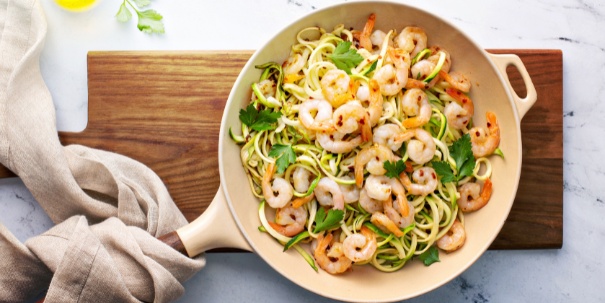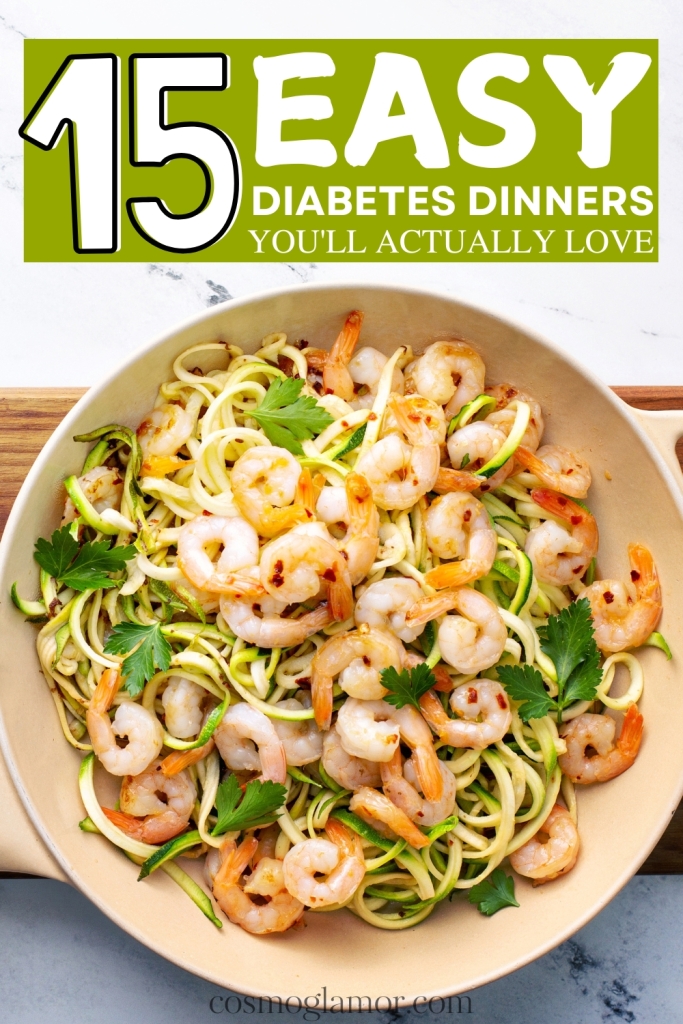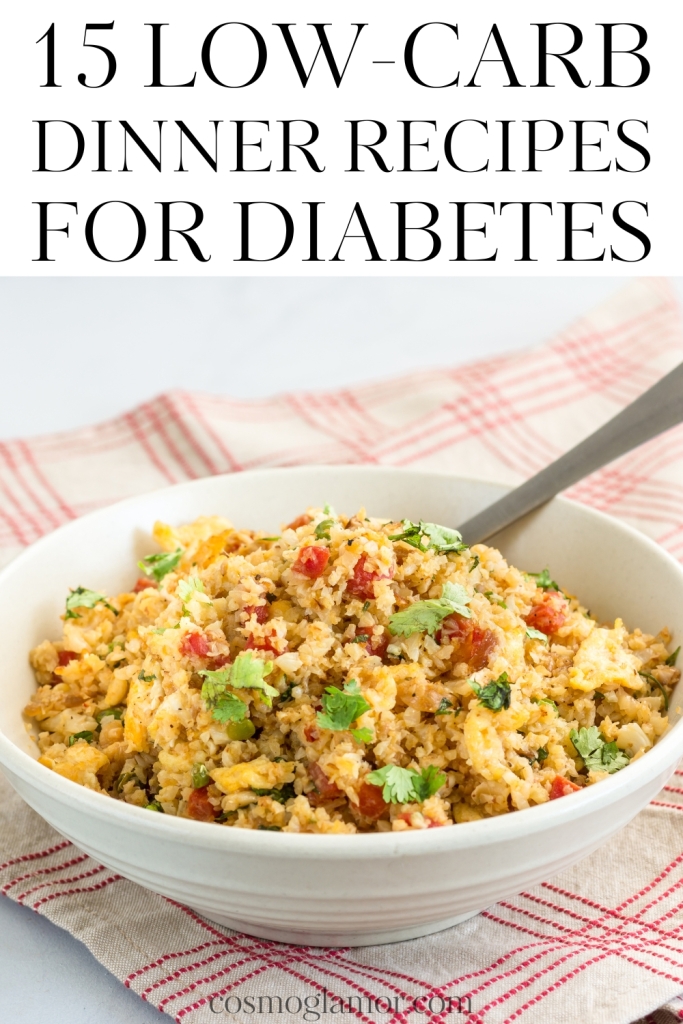Imagine a world where your favorite comfort foods no longer come with a side of guilt, where indulging in delicious dinners doesn’t mean sacrificing your health. For those managing diabetes, this might seem like a distant dream, but what if I told you it’s closer than you think?
Living with diabetes often involves navigating a maze of dietary restrictions, with carbohydrates often taking center stage. But managing blood sugar levels doesn’t have to mean resigning yourself to a life of bland and boring meals. In fact, with a little creativity and the right recipes, you can enjoy a diverse and satisfying diet without compromising your health.
This article unveils 15 delectable dinner recipes that are not only diabetes-friendly but also bursting with flavor. These meals are carefully curated to help you maintain stable blood sugar levels while providing the nourishment and enjoyment you deserve. Get ready to rediscover the joy of eating and embrace a lifestyle where deliciousness and diabetes management go hand in hand.
Diabetic-Friendly Delights: 15 Dinners You’ll Crave
Italian Favorites, Reimagined

Who says you have to give up Italian classics to manage your blood sugar? These innovative recipes offer a healthy twist on beloved dishes:
- Lasagna with Zucchini Noodles: This dish captures the essence of lasagna with a clever swap—zucchini noodles replace traditional pasta, significantly reducing the carb content. Enjoy the comforting layers of meat sauce, cheese, and zucchini without the blood sugar spike. (Calories: 314, Fat: 20g, Carbs: 5g, Protein: 28g)
- Chicken Parmesan with Zucchini Noodles: Another Italian staple gets a diabetes-friendly makeover. This recipe features tender chicken breasts coated in a crispy parmesan crust, served over a bed of zucchini noodles. It’s a satisfying and flavorful meal that won’t derail your blood sugar goals. (Calories: 330, Fat: 10.3g, Carbs: 18.9g, Protein: 39.2g)
- Spaghetti Squash with Meat Sauce: This dish offers a creative alternative to traditional spaghetti. Roasted spaghetti squash strands mimic the texture of pasta, providing a low-carb base for a rich and flavorful meat sauce. (Calories: 326, Fat: 9g, Carbs: 34g, Protein: 29g)
Comfort Food Classics, Reinvented

These recipes take comfort food to a whole new level, proving that you can enjoy satisfying and flavorful meals while managing diabetes:
- Chicken Pot Pie with Almond Flour Crust: This classic dish gets a low-carb makeover with a flaky almond flour crust. The creamy filling is packed with chicken and vegetables, offering a comforting and blood sugar-friendly meal. (Calories: 384, Fat: 20g, Carbs: 29g, Protein: 24g)
- Beef Stew: This hearty stew is a diabetes-friendly delight. It’s naturally low in carbs and packed with flavor, making it an ideal choice for maintaining stable blood sugar levels. (Calories: 296, Fat: 8g, Carbs: 18g, Protein: 31g)
- Bacon-Wrapped Meatloaf: This recipe adds a touch of indulgence to your dinner table. The meatloaf is wrapped in crispy bacon, creating a flavorful and satisfying meal that’s low in carbs and high in protein. (Calories: 403, Fat: 28g, Carbs: 9g, Protein: 27g)
Seafood Sensations

Dive into these delicious seafood dishes that are not only diabetes-friendly but also packed with essential nutrients:
- Shrimp Scampi with Zoodles: This recipe offers a lighter take on the classic shrimp scampi. Zucchini noodles replace pasta, keeping the carbs low and the protein high. It’s a flavorful and satisfying meal that’s perfect for managing blood sugar levels. (Calories: 251, Fat: 7g, Carbs: 5g, Protein: 39g)
- Baked Cod with Lemon and Herbs: This simple yet flavorful dish is a diabetes-friendly gem. Baked cod is infused with the zesty aroma of lemon and herbs, creating a light and satisfying meal that won’t disrupt your blood sugar. (Calories: 301, Fat: 15g, Carbs: 5.1g, Protein: 36.2g)
Global Flavors, Diabetes-Friendly

Explore the world of flavors with these internationally-inspired dishes that are tailored to meet your diabetes management needs:
- Korean Beef Bowl with Cauliflower Rice: This recipe brings the bold flavors of Korean cuisine to your dinner table. Tender beef is stir-fried with a savory sauce and served over a bed of cauliflower rice, keeping the carbs low and the taste high. (Calories: 386, Fat: 26.6g, Carbs: 12.9g, Protein: 24.7g)
Quick and Easy Diabetes-Friendly Dinners

These recipes are perfect for busy weeknights, offering quick and easy meal solutions that are both delicious and diabetes-friendly:
- Ground Turkey and Zucchini Skillet: This one-pan meal is a lifesaver for busy weeknights. Ground turkey and zucchini are cooked together with your favorite seasonings, creating a flavorful and low-carb dish that’s ready in minutes. (Calories: 272, Fat: 15g, Carbs: 11g, Protein: 25g)
- One-Pan Lemon Herb Chicken and Asparagus: This simple dish features roasted chicken and asparagus seasoned with zesty lemon and herbs. It’s a balanced and diabetes-friendly meal that’s quick to prepare and easy to clean up. (Calories: 338, Fat: 6g, Carbs: 21g, Protein: 49g)
Stuffed and Flavorful

These recipes showcase the versatility of vegetables, using them as vessels for delicious fillings that are both satisfying and diabetes-friendly:
- Stuffed Peppers: Bell peppers are transformed into edible bowls, filled with a savory mixture of ground meat, vegetables, and cheese. This dish offers a balanced and low-carb meal option that’s packed with flavor. (Calories: 381, Fat: 24g, Carbs: 17g, Protein: 24g)
- Mushroom-Stuffed Chicken Breasts: Chicken breasts are filled with a savory mushroom stuffing, creating a protein-rich and low-carb meal. This dish is both elegant and diabetes-friendly, perfect for a special occasion or a weeknight treat. (Calories: 575, Fat: 34g, Carbs: 7g, Protein: 60g)
Salads with a Twist

Salads don’t have to be boring! These creative options offer a burst of flavor and are perfect for a light yet satisfying diabetes-friendly dinner:
- “Big Mac” Salad: Craving a Big Mac but worried about the carbs? This salad captures all the iconic flavors—ground beef, pickles, special sauce—without the bun. It’s a fun and satisfying way to enjoy a fast-food favorite in a healthier way. (Calories: 368, Fat: 31g, Carbs: 3g, Protein: 18g)
Tips for Creating Your Own Diabetes-Friendly Dinners

While these 15 recipes offer a great starting point, you can also create your own diabetes-friendly dinners with a few simple guidelines:
Focus on Low-Carb Ingredients
- Embrace Non-Starchy Vegetables: Load up on vegetables like broccoli, spinach, cauliflower, and peppers. They are low in carbs and packed with essential nutrients.
- Choose Lean Protein Sources: Opt for lean protein sources like chicken, fish, turkey, and tofu. They help you feel full and satisfied without adding excessive carbs.
- Explore Healthy Fats: Include healthy fats like avocado, nuts, seeds, and olive oil in your meals. They contribute to satiety and help regulate blood sugar levels.
Portion Control Matters
Even with diabetes-friendly ingredients, portion control is crucial. Be mindful of your serving sizes to avoid overeating and keep your blood sugar in check.
Experiment with Flavors
Don’t be afraid to experiment with herbs, spices, and different cooking methods to add variety and excitement to your meals.
Beyond the Plate: Lifestyle Factors for Diabetes Management
While diet plays a crucial role in diabetes management, it’s not the only factor. Here are some additional lifestyle tips to complement your diabetes-friendly diet:
Regular Physical Activity
Engage in regular physical activity, such as brisk walking, cycling, or swimming. Exercise helps improve insulin sensitivity and regulate blood sugar levels. Aim for at least 30 minutes of moderate-intensity exercise most days of the week.
Stress Management
Chronic stress can negatively impact blood sugar levels. Practice stress management techniques like meditation, deep breathing exercises, or yoga to keep your stress levels in check.
Adequate Sleep
Getting enough sleep is crucial for overall health, including diabetes management. Aim for 7-9 hours of quality sleep each night.
Regular Monitoring
Regularly monitor your blood sugar levels as advised by your healthcare provider. This helps you track your progress and make necessary adjustments to your diet and lifestyle.
Living with diabetes doesn’t mean giving up on delicious food. By embracing these diabetes-friendly dinner recipes and incorporating healthy lifestyle habits, you can savor the joy of eating while keeping your blood sugar levels in check. Remember, a balanced and flavorful diet is not only possible but also essential for a fulfilling life with diabetes.
References
- The effect of a low-carbohydrate, ketogenic diet versus a low-glycemic index diet on glycemic control in type 2 diabetes mellitus: A randomized controlled trial.
- Effect of a Mediterranean diet supplemented with nuts on metabolic syndrome status: results from the PREDIMED study.
- A low-carbohydrate as compared with a low-fat diet in severe obesity.
- Primary prevention of cardiovascular disease with a Mediterranean diet.
- Long-term effects of a very-low-carbohydrate weight loss diet compared with an isocaloric low-fat diet after 12 mo.
- Dietary carbohydrate restriction as the first approach in diabetes management: Critical review and evidence base.
- Effect of dietary fiber on glycemic control and cardiovascular risk factors in patients with type 2 diabetes mellitus: A systematic review and meta-analysis of randomized controlled trials.
- The role of dietary fat in type 2 diabetes.
- Effect of a high-protein diet versus standard-protein diet on weight loss and biomarkers of metabolic syndrome in individuals with pre-diabetes and type 2 diabetes: a systematic review and meta-analysis of randomized clinical trials.








16 Responses
I was just diagnosed with type 2 diabetes, and I’m feeling pretty overwhelmed. This article is a lifesaver! I love Italian food, but I thought I had to give it up. The Zucchini Noodle Lasagna sounds amazing. Is it really as good as regular lasagna?
Hi Em, I’m so glad you found the article helpful! It’s understandable to feel overwhelmed with a new diagnosis, but please know that you can still enjoy delicious food. The Zucchini Noodle Lasagna is truly delicious. While it has a slightly different texture than traditional lasagna, the flavors are all there, and it’s incredibly satisfying. Many people even prefer it! Give it a try and let me know what you think. You’ve got this!
I’m excited to try these recipes, but I’m a little confused about portion sizes. How do I know how much to eat to keep my blood sugar stable? The calorie counts are helpful, but I’m not sure how that translates to portion sizes.
Hi Jessica, That’s a great question! Portion control is definitely key for managing blood sugar. The calorie counts give you a general idea, but the best approach is to use measuring cups and a food scale, especially when starting. It’s also important to monitor your blood sugar levels before and after meals to see how different foods affect you. Your doctor or a registered dietitian can help you determine the appropriate portion sizes for your individual needs.
These recipes look great, and I appreciate the nutritional information included. My question is about the carb counts. Some of these, like the Spaghetti Squash with Meat Sauce, still seem relatively high in carbs (34g). I understand it’s a better alternative to regular pasta, but for someone strictly monitoring their carb intake, is this still a good choice? Are there any further modifications that could be made to lower the carbs even more?
Hi Deborah, thanks for your insightful question. You’re right to be mindful of the carb counts, even in healthier alternatives. While spaghetti squash is significantly lower in carbs than traditional pasta, it still contains carbohydrates. 34g of carbs for the Spaghetti Squash with Meat Sauce might be a bit high for some individuals with diabetes, especially those following a very low-carb diet.
Here are some ways to further reduce the carb content:
Reduce the portion size: This is the simplest way to lower carbs. Consider having a smaller serving of the spaghetti squash.
Increase the vegetable content in the meat sauce: Adding more non-starchy vegetables like mushrooms, bell peppers, or spinach to the sauce will add volume and nutrients without significantly increasing the carb count.
Consider using a different base: While not quite the same, you could experiment with using even lower-carb alternatives like shirataki noodles (made from konjac yam) or spiralized celeriac.
It’s important to remember that everyone’s carb tolerance is different. Monitoring your blood sugar levels after meals will help you determine how different foods affect you personally. Thanks for raising this important point about carb management!
This is a fantastic list of dinner ideas! I’m always looking for new diabetes-friendly recipes. I’m curious, though, about the use of certain ingredients. For example, some recipes include bacon. While it adds flavor, it’s also high in saturated fat. Are there any healthier alternatives to bacon that could be used without sacrificing too much flavor? Also, how can I ensure the sauces used in some of these dishes are also diabetes-friendly (low in sugar)?
Hi Rebecca, thanks for your comment! You’re right to be mindful of saturated fat and added sugars, especially when managing diabetes. Here are some healthier alternatives to bacon and tips for making sauces diabetes-friendly:
Alternatives to Bacon:
Turkey bacon: This is a lower-fat option compared to regular bacon.
Smoked paprika: This spice can add a smoky flavor to dishes, mimicking some of the taste of bacon without the added fat.
Smoked salt: A pinch of smoked salt can also provide a similar smoky flavor.
Mushrooms: When cooked properly, some varieties of mushrooms can develop a savory, almost bacon-like flavor.
Making Diabetes-Friendly Sauces:
Use fresh herbs and spices: These add flavor without added sugars.
Use low-sodium broth: This provides a flavorful base for sauces without excess sodium.
Thicken sauces with xanthan gum or arrowroot powder: These are low-carb thickening agents.
Avoid added sugars: Instead of using sugar or honey, consider using small amounts of natural sweeteners like stevia or erythritol (in moderation).
For the Bacon-Wrapped Meatloaf, for example, you could try using turkey bacon or adding smoked paprika to the meatloaf mixture. For sauces in other dishes, focus on using fresh herbs, spices, and low-sodium broth. Thanks for asking these important questions about healthy substitutions!
Wow, these recipes look amazing! I’m always looking for new diabetes-friendly meals, and the lasagna with zucchini noodles sounds especially interesting. I’ve tried zucchini noodles before, but they sometimes get watery. Do you have any tips for preventing that? Also, the nutritional information is helpful, but is it per serving? It would be great to know the serving size for each recipe.
Hi Deborah, thanks for your comment! I’m glad you found the recipes helpful. You’re right, zucchini noodles can sometimes get watery. A few tricks can help:
Salt and drain: After spiralizing the zucchini, lightly salt them and let them sit in a colander for about 15-20 minutes. This draws out excess moisture. Then, gently squeeze them dry with paper towels or a clean kitchen towel.
Don’t overcook: Zucchini noodles cook very quickly. Avoid overcooking them, as this will release more water. A quick sauté or light roasting is usually sufficient.
Pat dry before adding to the dish: Even after draining, pat the noodles dry again before incorporating them into your recipe.
And yes, the nutritional information provided is per serving. I will make sure to explicitly include the serving size for each recipe in future posts to avoid any confusion. Thanks for pointing that out! I hope you enjoy the lasagna!
These recipes are a good start, and I appreciate the focus on low-carb alternatives. However, I’m a bit concerned about the reliance on meat in some of these dishes, like the bacon-wrapped meatloaf and the beef stew. While protein is important, excessive red meat consumption has been linked to other health issues. Are there any vegetarian or vegan options that are also diabetes-friendly? Also, for the global flavors section, is there any consideration for sodium content, especially in dishes like the Korean beef bowl? Many prepared sauces can be very high in sodium.
Hi Kimberly, thanks for your thoughtful comment and for raising those important points. You’re absolutely right to be mindful of red meat consumption. While these recipes offer variety, balancing them with other protein sources is key. I am working on adding more vegetarian and vegan diabetes-friendly recipes. Some great options to consider are lentil soups, chickpea curries (using low-sodium ingredients), tofu stir-fries with plenty of non-starchy vegetables, and hearty salads with beans or quinoa. These can be just as satisfying and offer excellent nutritional profiles.
Regarding the sodium content, especially in dishes like the Korean beef bowl, you’re spot on. Many commercially prepared sauces are indeed high in sodium. When preparing these dishes, I strongly recommend using low-sodium soy sauce or tamari, and controlling the amount of added salt. Fresh herbs, spices, and citrus juices can be used to boost flavor without relying on sodium. I will also strive to include sodium content information in future recipes to help readers make informed choices. Thanks for bringing this to my attention!
Okay, so courgette ribbons are ALL over this article. I get it, they’re low carb. But honestly, do they really taste like pasta? I’m skeptical. Also, a “Big Mac” salad? Come on, is that even a thing? I love a good Big Mac, but lettuce just isn’t the same as a sesame seed bun. And my biggest question: Where’s the pudding? A girl’s gotta have some pud, even with diabetes! Any suggestions on that front would be greatly appreciated!
Hi Pippa, thanks for your comment! You’re right, courgette ribbons are a popular pasta substitute for those watching their carbs. While they don’t taste exactly like traditional pasta, they do a pretty good job of soaking up sauces and providing a similar texture, especially when they’re cooked al dente. The “Big Mac” salad is surprisingly tasty! It captures the flavours of the burger with seasoned ground beef, pickles, and a special sauce, all while being low-carb. As for pudding, that’s a great point! This article focused on dinners, but I should include dessert options. Stay tuned for a future article on diabetes-friendly puddings. In the meantime, small portions of berries with a dollop of unsweetened whipped cream, or a square of dark chocolate (70% cacao or higher) can satisfy a sweet tooth without a major blood sugar spike. Thanks for the suggestion!
This is a great list of recipes, and I appreciate the calorie counts. But I’m a busy mum with a picky family. Are these recipes really kid-friendly? My little ones run for the hills at the sight of anything green, except maybe green sweets. Also, almond flour? Isn’t that, like, dead expensive? Is there a cheaper alternative that won’t totally wreck the recipes, since I haven’t got a lot of dosh right now?
Hi Gemma, I understand your concerns! Feeding a family, especially with picky eaters, can be a challenge. While these recipes are designed to be flavorful, some kids might need a little convincing. You could try introducing the dishes gradually. For example, the Chicken Parmesan with Courgette Ribbons could be served with a side of regular pasta for the kids initially, slowly increasing the courgette portion over time. And the “Big Mac” salad could be served with the components separated, allowing them to build their own. As for almond flour, you’re right, it can be pricey. You could try substituting a portion of it with a blend of oat flour or even whole wheat flour, although that will slightly increase the carb count. It might take some experimentation to find the right balance for your family’s taste and budget. Thanks for your valuable feedback, and good luck with meal prepping!